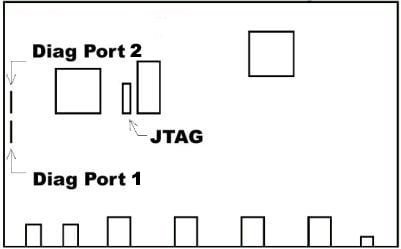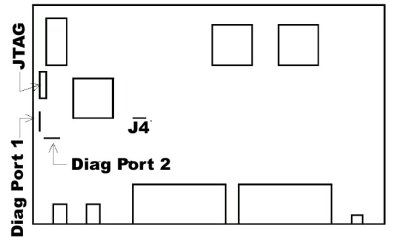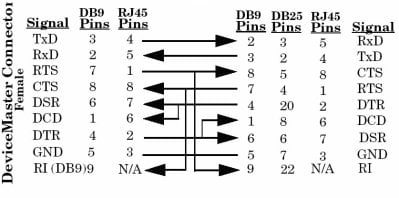
|  | DeviceMaster Software Developer Kit Using the Diagnostic Serial PortThe DeviceMaster circuit board has two diagnostic serial ports. Each port is accessed via 4-Pin header near one end of the board.
The signal levels on the headers are not RS-232, and a converter cable is required to convert them to RS-232 levels for use with a standard serial port.
The DeviceMaster circuit board has two diagnostic serial ports. Each port is accessed via 4-Pin header near one end of the board.
The signal levels on the headers are not RS-232, and a converter cable is required to convert them to RS-232 levels for use with a standard serial port. ![[Note]](images/note.gif) | | Note |
|---|
The converter cable is included with the Software Development Kit. |
|
The first diagnostic port is used for diagnostic output from calls to diag_printf(). It is also used by
RedBoot as a command console.
The second diagnostic port also functions as a RedBoot console port. The second port can be used for a serial remote GDB connection, see
Using GDB with Diagnostic Port 2 . The positions of these connectors are shown in the figures below. 4/8-Port Board (Top View) 16-Port Board (Top View) Use the following procedure to set up the diagnostic serial port: Plug the diagnostic cable into the first diagnostic port (Diag Port 1) and connect it to a serial port configured for:
57600 baud 8 data bits no parity 1 stop bit No flow control
Connect a null-modem cable from an available COM port on your PC to serial Port 1 on the DeviceMaster.
![[Note]](images/note.gif) | | Note |
|---|
You may want to purchase or build a straight-through cable and purchase a null-modem adapter. |
|
If you monitor the data from that port and cycle power on the DeviceMaster, you should see startup messages from the
bootloader and then a prompt:
RAM OK
Sum OK
+
Comtrol DeviceMaster Boot Version 1.06
RedBoot(tm) debug environment - built 14:18:19, Jul 18 2001
Platform: Comtrol DeviceMaster (ARM 7TDMI)
Portions Copyright (C) 2000, Red Hat, Inc.
Portions Copyright (C) 2001, Comtrol Corp.
FLASH: 0x05030000 - 0x05400000, 61 blocks of 0x00010000 bytes each.
ks32c5000_eth_init()
found MAC address 00:C0:4E:0B:FF:F9
ks5000_ether: installInterrupts()
EthInit(00:C0:4E:0B:FF:F9)
ks32C5000 eth: 00:C0:4E:0B:FF:F9 Hardware CRC
ks32c5000_eth_start()
IP: 192.168.250.250, Mask: 255.255.255.0, Gateway: 192.168.250.1,
Server: 0.0.0.0
RedBoot>
At this point you can type bootloader commands. If a default application is configured in flash, and the default application
time-out is set (15 seconds), you will see the default application start up after the time-out period:
ARM DeviceMaster HAL (no virtual vectors)
AIOPIC serial driver: 16 channels
ks32c5000 old_init_handler()
Network stack using 262144 bytes for misc space
262144 bytes for mbufs
524288 bytes for mbuf clusters
ks32c5000_eth_init()
found MAC address 00:C0:4E:0B:FF:F9
ks5000_ether: installInterrupts()
EthInit(00:C0:4E:0B:FF:F9)
ks32C5000 eth: 00:C0:4E:0B:FF:F9 Hardware CRC
SocketServer 1.13
Copyright Comtrol Corp. 2001
Build date: Tue Jun 19 12:21:54 CDT 2001
Free RAM at 280700, Len = 53F900
starting madmin
Bg started
madmin running
madmin MyMacAddr=00:C0:4E:0B:FF:F9
ks32c500 old_set_config_handler()
ks32c5000_eth_start()
IP = 0A000005
Mask = FF000000
Gate = 0A000001
Net init complete.
Net init done
socket server init
socket server active config: 05002000
TcpRx0: waiting on semaphore
TcpTx0 started
[...]
|  |









![[Note]](images/note.gif)
